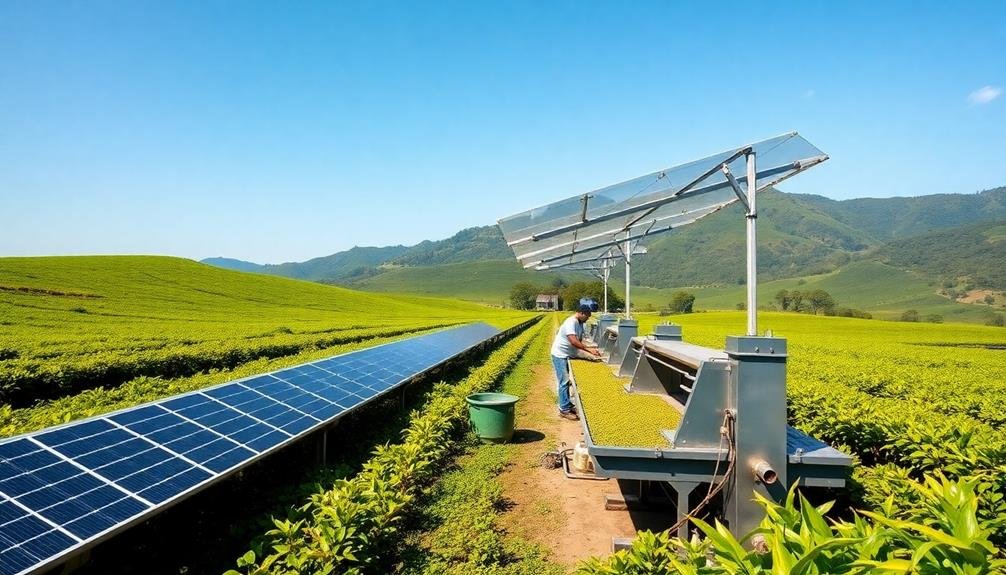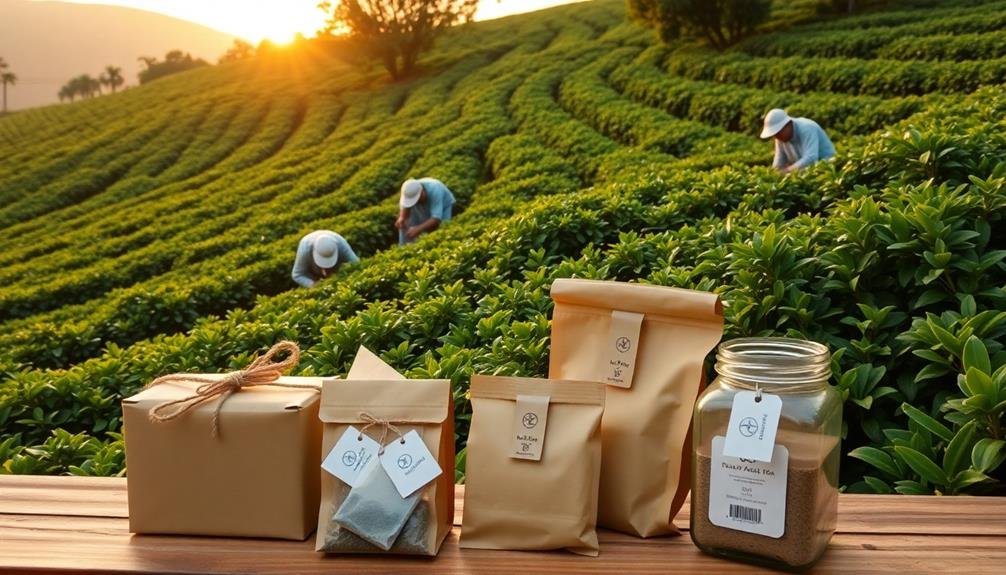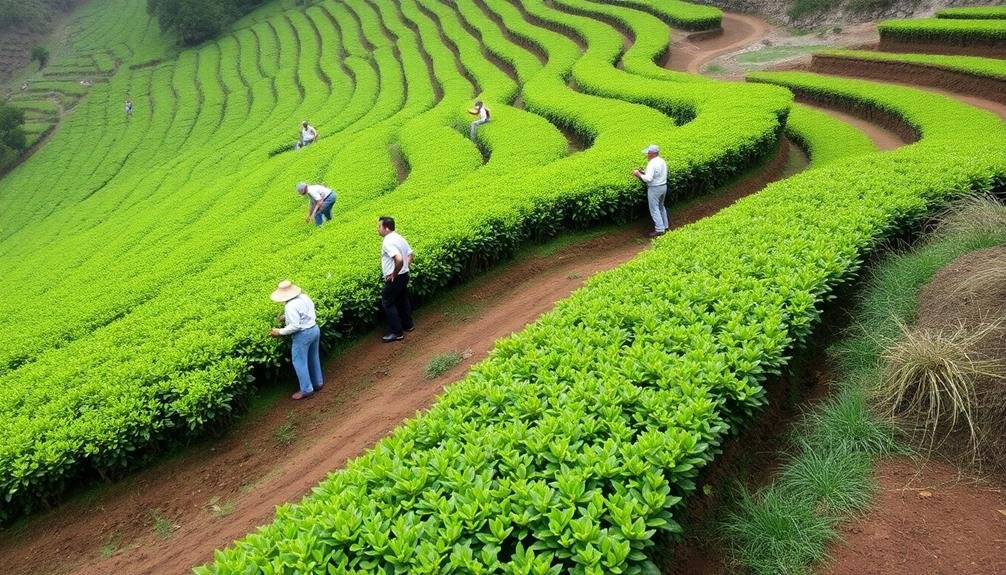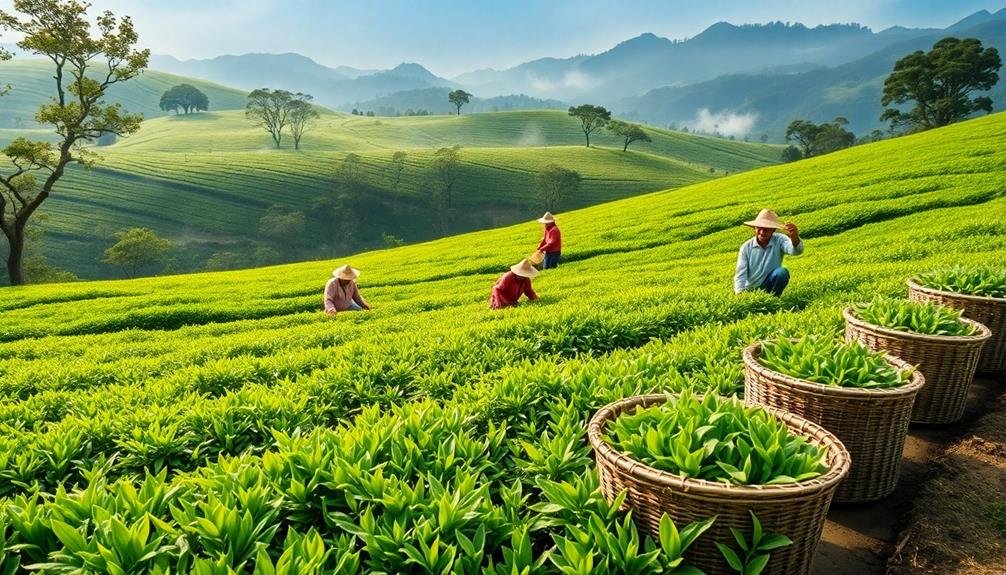Eco-friendly tea harvesting is your gateway to sustainable sipping. It focuses on conserving resources, reducing chemical inputs, and promoting fair trade practices. You'll find organic farming methods that eliminate synthetic pesticides and fertilizers, while responsible water management techniques like rainwater harvesting guarantee efficiency. Biodiversity in tea gardens supports natural pest control and soil fertility. Energy-efficient processing, including solar-powered drying systems, reduces carbon footprints. Fair trade certifications assure ethical labor practices and community support. By choosing sustainably harvested teas, you're not just enjoying a better cup, but also contributing to environmental conservation and social responsibility. Dive deeper to uncover the full spectrum of eco-friendly tea production.
Understanding Sustainable Tea Production

Embracing sustainable tea production is vital for the long-term health of both the environment and the tea industry. When you choose sustainably produced tea, you're supporting practices that minimize environmental impact and promote social responsibility.
Sustainable tea farming focuses on conserving natural resources, reducing chemical inputs, and preserving biodiversity. You'll find that eco-friendly tea production methods include organic farming, which eliminates synthetic pesticides and fertilizers. Instead, farmers use natural pest control methods and compost to nourish the soil.
Agroforestry techniques, where tea plants are grown alongside other trees, help maintain ecosystem balance and provide additional income sources for farmers.
Water management is important in sustainable tea production. Efficient irrigation systems and rainwater harvesting reduce water waste and protect local water sources.
Energy conservation is also a priority, with many sustainable tea farms utilizing renewable energy sources like solar or wind power.
Fair trade practices guarantee that workers receive fair wages and safe working conditions. By supporting these initiatives, you're contributing to the well-being of tea-growing communities and helping to create a more sustainable future for the industry.
Organic Tea Farming Methods
When you explore organic tea farming methods, you'll find that natural pest control is a key component.
You'll learn about techniques like introducing beneficial insects and using plant-based repellents to protect tea crops without harmful chemicals.
Additionally, you'll discover the importance of soil health management, which involves practices like composting and crop rotation to maintain nutrient-rich growing conditions for tea plants.
Natural Pest Control
In organic tea farming, natural pest control methods play a significant role. You'll find that these techniques protect tea plants from harmful insects and diseases without resorting to synthetic chemicals.
One effective approach is companion planting, where you grow certain plants alongside tea bushes to repel pests naturally. For example, planting marigolds or chrysanthemums can deter nematodes and other harmful insects.
You can also introduce beneficial insects like ladybugs, lacewings, and praying mantises to your tea garden. These predators feed on common tea pests, maintaining a natural balance.
Another method you'll want to take into account is using neem oil, a natural insecticide derived from the neem tree. It's effective against a wide range of pests and is safe for beneficial insects.
Crop rotation is another essential technique you shouldn't overlook. By rotating tea crops with other plants, you'll disrupt pest life cycles and improve soil health.
Soil Health Management
Just as natural pest control methods protect tea plants above ground, organic soil health management nurtures them from below. You'll find that maintaining healthy soil is essential for producing high-quality, eco-friendly tea. Start by regularly testing your soil's pH and nutrient levels to guarantee ideal growing conditions for your tea plants.
Implement crop rotation and cover cropping to prevent soil depletion and erosion. You'll want to use organic fertilizers like compost, manure, and green manures to enrich the soil naturally. Mulching helps retain moisture and suppress weeds, reducing the need for chemical interventions.
Here's a quick guide to organic soil amendments for tea farming:
| Amendment Type | Benefits | Application Frequency |
|---|---|---|
| Compost | Improves soil structure | Annually |
| Bone meal | Provides phosphorus | Every 2-3 years |
| Fish emulsion | Boosts nitrogen | Monthly during growing season |
| Rock dust | Adds minerals | Every 3-4 years |
| Seaweed extract | Enhances micronutrients | Bi-monthly |
Responsible Water Management

When it comes to responsible water management in tea farming, you'll find two key practices gaining popularity.
Rainwater collection systems allow you to capture and store natural precipitation for use during drier periods.
You can also implement drip irrigation techniques, which deliver water directly to the plant roots, minimizing waste and maximizing efficiency.
Rainwater Collection Systems
Capturing rainwater offers tea plantations a sustainable solution for responsible water management. You'll find that implementing a rainwater collection system can greatly reduce your reliance on groundwater and local water sources.
By installing gutters, downspouts, and storage tanks, you're able to harvest and store rainwater for various plantation needs.
To set up an effective rainwater collection system, you'll need to:
- Assess your plantation's layout and identify ideal collection points
- Install high-quality gutters and downspouts to direct water flow
- Set up large storage tanks or cisterns to hold collected rainwater
- Implement a filtration system to guarantee water quality for irrigation
Once you've established your rainwater collection system, you can use the stored water for irrigation during dry periods, reducing your overall water consumption.
This approach not only conserves local water resources but also helps protect your tea plants from drought stress. Additionally, you'll find that rainwater is naturally soft and free from chemicals, making it perfect for nurturing your tea crops.
Drip Irrigation Techniques
Drip irrigation stands out as another effective method for responsible water management in tea plantations. This technique delivers water directly to the plant's roots, minimizing waste and maximizing efficiency. You'll find that drip irrigation can reduce water usage by up to 60% compared to traditional methods.
To implement drip irrigation, you'll need to install a network of pipes and emitters throughout your tea garden. These systems can be customized to suit your specific needs, taking into account factors like soil type, plant spacing, and climate conditions.
Here's a quick overview of drip irrigation components and their functions:
| Component | Function |
|---|---|
| Main line | Distributes water from source |
| Sub-main lines | Branch off main line |
| Laterals | Connect to sub-mains |
| Emitters | Release water to plants |
| Filters | Remove debris from water |
You'll appreciate the benefits of drip irrigation beyond water conservation. It can improve tea plant health by maintaining consistent soil moisture, reducing weed growth, and minimizing soil erosion. Additionally, you can use this system to deliver nutrients directly to the plants through fertigation, enhancing overall productivity and sustainability in your tea garden.
Biodiversity in Tea Gardens
Tea gardens are home to a rich tapestry of life, supporting far more than just tea plants. When you visit a well-managed tea garden, you'll find a thriving ecosystem that promotes biodiversity. This diversity isn't just beautiful; it's vital for sustainable tea production and environmental health.
Biodiversity in tea gardens contributes to natural pest control, soil fertility, and pollination. You'll often see birds, insects, and small mammals playing significant roles in maintaining the garden's balance.
By encouraging diverse plant species alongside tea bushes, garden managers create habitats for beneficial organisms and improve overall ecosystem resilience.
To understand the biodiversity in a tea garden, look for these key elements:
- Native shade trees interspersed among tea plants
- Flowering plants attracting pollinators and beneficial insects
- Diverse ground cover protecting soil and supporting microorganisms
- Water features like ponds or streams hosting aquatic life
Energy-Efficient Processing Techniques

You'll find that energy-efficient processing techniques are revolutionizing tea production.
Solar-powered drying systems harness renewable energy to reduce carbon emissions, while optimized withering techniques minimize energy consumption during the essential first step of tea processing.
Low-impact packaging methods further reduce the environmental footprint of tea production, ensuring that your cup of tea is as eco-friendly as possible.
Solar-Powered Drying Systems
Rays of sunlight power innovative drying systems in modern tea processing. These solar-powered methods are revolutionizing the way you enjoy your favorite brew while reducing the industry's carbon footprint.
By harnessing the sun's energy, tea producers can dry their leaves efficiently and sustainably, preserving the delicate flavors and aromas you love.
Solar-powered drying systems offer numerous benefits for both the environment and tea quality. Here's how they work:
- Solar panels capture sunlight and convert it into electricity
- This energy powers fans and heating elements in drying chambers
- Tea leaves are spread evenly on racks within these chambers
- Controlled airflow and temperature guarantee ideal drying conditions
You'll appreciate the improved consistency and flavor profile of solar-dried teas.
These systems allow for precise temperature control, preventing over-drying or uneven results. They're also more cost-effective in the long run, reducing energy expenses for tea producers.
Optimized Withering Techniques
Three key innovations in withering techniques are revolutionizing tea processing efficiency. You'll find that controlled airflow systems, temperature-regulated chambers, and moisture monitoring devices are leading the charge in optimizing this vital stage of tea production.
Controlled airflow systems use precisely directed air currents to guarantee even withering across all leaves. This eliminates the need for manual leaf turning, reducing labor costs and energy consumption. Temperature-regulated chambers maintain ideal conditions for the withering process, preventing over-drying or under-withering that can compromise tea quality.
Moisture monitoring devices allow you to track the leaves' water content in real-time, enabling you to make data-driven decisions about when to end the withering process. This precision results in consistent quality and reduced energy waste.
Here's a comparison of traditional and optimized withering techniques:
| Aspect | Traditional Method | Optimized Method |
|---|---|---|
| Duration | 12-18 hours | 8-12 hours |
| Energy Use | High | Moderate |
| Labor | Intensive | Minimal |
| Consistency | Variable | Highly consistent |
| Quality Control | Limited | Precise |
Low-Impact Packaging Methods
Low-impact packaging methods are revolutionizing the tea industry's approach to sustainability. As a conscientious tea drinker, you'll be pleased to know that eco-friendly packaging options are becoming more prevalent. These innovations aim to reduce waste, minimize environmental impact, and preserve tea quality.
When shopping for sustainably packaged tea, look for these low-impact options:
- Biodegradable tea bags made from corn starch or other plant-based materials
- Loose leaf tea in reusable or recyclable tins
- Compostable packaging made from recycled paper or bamboo
- Bulk tea options that allow you to bring your own containers
By choosing teas with low-impact packaging, you're supporting companies that prioritize sustainability. These methods often use fewer resources and energy in production, further reducing their carbon footprint.
Additionally, many eco-friendly packages are designed to maintain tea freshness without relying on harmful chemicals or excessive plastic.
Fair Trade Practices
Justice and sustainability go hand in hand when it comes to fair trade practices in tea harvesting. When you choose fair trade certified teas, you're supporting a system that guarantees tea farmers and workers receive fair wages and work in safe conditions. These practices help create sustainable livelihoods for communities in tea-growing regions.
Fair trade certification also promotes environmentally friendly farming methods. It encourages the use of organic practices, prohibits harmful pesticides, and supports biodiversity conservation. By purchasing fair trade teas, you're indirectly contributing to the protection of local ecosystems and wildlife habitats.
Moreover, fair trade initiatives often invest in community development projects. These can include building schools, improving healthcare facilities, or providing clean water access. Your choice to buy fair trade tea helps fund these essential improvements in tea-growing communities.
To identify fair trade teas, look for certifications from organizations like Fairtrade International or Fair Trade USA on product packaging. By making this conscious choice, you're voting with your wallet for a more equitable and sustainable tea industry.
Eco-Friendly Packaging Solutions

Packaging tea sustainably is an essential aspect of eco-friendly tea harvesting. You'll find that many tea companies are now adopting innovative solutions to reduce their environmental impact. These eco-friendly packaging options not only preserve the tea's quality but also minimize waste and pollution.
When shopping for sustainably packaged tea, look for these features:
- Biodegradable or compostable tea bags made from materials like organic cotton, hemp, or cornstarch
- Recyclable or reusable containers, such as glass jars or tin canisters
- Minimal packaging that uses recycled or FSC-certified paper and cardboard
- Plant-based inks and adhesives for printing and sealing
You'll also want to reflect on the packaging's overall lifecycle. Some companies now offer refill programs, allowing you to reuse your original container and simply purchase loose tea refills. This approach greatly reduces waste and your carbon footprint.
Additionally, you can opt for loose leaf tea and use your own reusable infuser, eliminating the need for disposable tea bags altogether. By choosing eco-friendly packaging solutions, you're not only enjoying a delicious cup of tea but also contributing to a more sustainable future for the tea industry and our planet.
Carbon Footprint Reduction Strategies
Numerous strategies exist for reducing the carbon footprint in tea harvesting. You can start by implementing energy-efficient practices in your tea processing facilities. This includes using solar panels for electricity generation, installing LED lighting, and optimizing machinery for better energy consumption.
Consider shifting to electric or hybrid vehicles for transporting tea leaves from fields to processing plants. You'll greatly cut down on fossil fuel usage and emissions.
Implementing precision agriculture techniques can help you optimize fertilizer and pesticide use, reducing both costs and environmental impact.
Adopt water conservation methods like drip irrigation and rainwater harvesting. These practices not only save water but also reduce the energy needed for pumping and distribution.
You can also explore carbon sequestration techniques, such as planting cover crops or incorporating biochar into your soil.
Don't forget about your supply chain. Work with suppliers who prioritize sustainability and choose shipping methods with lower carbon emissions.
Preserving Traditional Harvesting Techniques

Traditional tea harvesting techniques are an essential part of the industry's cultural heritage. As you explore eco-friendly tea options, you'll find that many producers are working to preserve these time-honored methods. By supporting these practices, you're not only enjoying a superior product but also helping to maintain centuries-old traditions.
When you picture traditional tea harvesting, imagine:
- Skilled pickers carefully selecting only the finest leaves and buds
- Woven baskets slung over shoulders, filled with freshly plucked leaves
- Harvesters moving methodically through misty mountain plantations
- The gentle rustle of leaves as experienced hands swiftly work
These techniques often result in higher quality tea and lower environmental impact. They're labor-intensive but provide employment for local communities and guarantee each leaf is harvested at its peak.
You'll find that teas produced using traditional methods often have a more complex flavor profile and are prized by connoisseurs.
Sustainable Pest Management
Pest control challenges in tea plantations can be addressed through sustainable practices that protect both the crop and the environment.
You'll find that eco-friendly tea farms are increasingly adopting integrated pest management (IPM) strategies. These methods prioritize biological controls over chemical pesticides, maintaining a delicate balance in the ecosystem.
You can expect to see beneficial insects like ladybugs and lacewings introduced to control harmful pests naturally. Pheromone traps and sticky traps are also common, attracting and capturing insects without using harmful chemicals.
Some farms employ companion planting, where specific plants are grown alongside tea bushes to repel pests or attract beneficial insects.
When you visit sustainable tea gardens, you might notice bird perches and nesting boxes. These encourage natural predators to control pest populations.
In cases where pesticides are necessary, you'll find farmers using organic, plant-based options like neem oil or pyrethrin. They'll also time applications carefully to minimize impact on beneficial insects and pollinators.
Soil Conservation in Tea Plantations

While effective pest management protects tea plants above ground, soil conservation safeguards the foundation of tea production.
You'll find that maintaining healthy soil is essential for sustainable tea cultivation. Soil erosion, nutrient depletion, and compaction are common challenges in tea plantations, but you can combat these issues with smart conservation practices.
To preserve soil quality and promote long-term sustainability, you should implement these key strategies:
- Contour planting: Align tea bushes along hillside contours to reduce water runoff and soil erosion.
- Cover cropping: Plant beneficial ground cover between tea rows to improve soil structure and prevent erosion.
- Mulching: Apply organic mulch around tea plants to retain moisture, suppress weeds, and add nutrients.
- Terracing: Create level platforms on steep slopes to minimize erosion and maximize water retention.
Ethical Labor Practices
In accordance with sustainable tea production, ethical labor practices form an essential pillar of eco-friendly harvesting. As a conscious consumer, you'll want to ascertain that the tea you enjoy is produced under fair and safe working conditions.
Look for certifications like Fair Trade or Rainforest Alliance, which guarantee that workers receive fair wages and operate in safe environments.
You can support tea brands that prioritize their workers' well-being by providing healthcare, education, and housing benefits. These companies often invest in community development projects, empowering local populations and fostering long-term sustainability.
Be aware of child labor issues in the tea industry. Choose brands that explicitly prohibit child labor and have transparent supply chains.
You can also research companies' policies on gender equality, as many tea pickers are women who face unique challenges.
Supporting Local Tea Communities

Tea lovers can play an essential role in supporting local tea communities. By choosing sustainably sourced teas, you're directly contributing to the well-being of tea-growing regions and their inhabitants.
Look for brands that prioritize fair trade practices and invest in community development projects. These initiatives often focus on education, healthcare, and infrastructure improvements, empowering local populations and fostering long-term sustainability.
When you support local tea communities, you're helping to:
- Preserve traditional tea-making techniques and cultural heritage
- Provide fair wages and better working conditions for tea farmers
- Invest in eco-friendly farming practices that protect the environment
- Enhance economic stability in rural areas, reducing urban migration
Consider participating in tea tourism or virtual tea experiences that connect you directly with tea-growing communities. These activities offer unique insights into the tea production process and allow you to forge meaningful connections with local artisans.
Frequently Asked Questions
How Does Altitude Affect the Taste of Sustainably Grown Tea?
Altitude considerably impacts your tea's flavor. You'll notice higher-grown teas have more complex, nuanced tastes. They're often crisper and more aromatic. Lower altitudes produce teas with fuller bodies and richer, earthier notes. It's all about elevation's influence.
Can I Compost Used Tea Leaves From Eco-Friendly Tea Brands?
Yes, you can compost used tea leaves from eco-friendly brands. They're an excellent addition to your compost pile, enriching it with nutrients. Just make sure to remove any staples or tags before tossing them in. It's a great way to recycle!
Are There Health Benefits Specific to Sustainably Harvested Teas?
You'll find sustainably harvested teas offer similar health benefits to conventional teas. They're rich in antioxidants and may boost your immune system. However, they're often fresher and less processed, potentially enhancing their nutritional value and flavor profile.
How Long Does Sustainably Produced Tea Typically Stay Fresh?
You'll find sustainably produced tea stays fresh for about 6-12 months when stored properly. Keep it in an airtight container away from light, heat, and moisture. It's best to consume it within this timeframe for ideal flavor.
What's the Environmental Impact of Different Tea Brewing Methods?
You'll find that different brewing methods have varying environmental impacts. Electric kettles are energy-efficient, while stovetop kettles use more energy. Loose leaf tea produces less waste than tea bags, especially plastic ones. Consider reusable filters for sustainability.
In Summary
You've now got the knowledge to make eco-conscious choices in your tea consumption. By supporting sustainable tea production, you're not just enjoying a delicious brew, but also contributing to environmental conservation and ethical farming practices. Remember, every cup counts. Choose organic, look for fair trade labels, and consider the impact of your purchases. Your sustainable steeping journey doesn't end here—keep exploring and advocating for responsible tea production. Together, we can make a difference, one cup at a time.





Leave a Reply